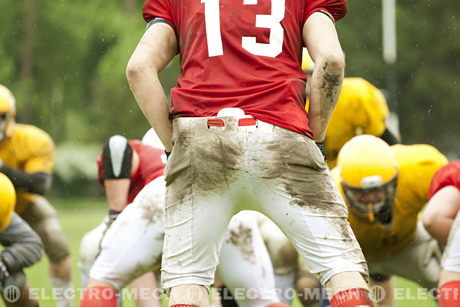
- Understanding the proper mechanics is essential to throwing a football correctly
- Elements of the throw include proper grip, throwing position, and motion
- Twisting the torso while throwing can add to the velocity of a throw
Gripping the Ball
The index finger of the throwing hand should be positioned so that the tip of the finger is on a seam of the ball, near but not on the point of the ball. The thumb should be positioned so that it forms an L shape with the index finger. The middle finger should be at the end of the laces, with the ring finger and little finger on the laces. A quarterback with a smaller hand may need to have only the little finger on the laces, whereas a quarterback with a larger hand may have the middle finger on the laces in addition to the other two. The ball should be gripped lightly with the fingertips; the palm should be arched and not lie flat against the ball. As the ball is thrown, the index finger is the last finger to maintain contact with the ball; doing this properly can cause the ball to spin in a spiral, increasing accuracy.
Positioning the Body
The ball should be held up near the ear to allow for a quick release. The throwing hand should grip the ball in the manner described above, with the other hand cupping the other side of the ball for balance. The thrower’s feet should be slightly more than shoulders’ width apart, with the knees slightly bent. The body is turned sideways to the target so that a straight line can be drawn through the target and both of the feet. The non-throwing arm is held up and out to the side for balance.
Creating the Correct Throwing Motion
The throwing motion begins with the throwing hand bringing the ball back past the shoulder and the other hand releasing from the ball. At the same time, the player should turn his hips to create torque. As the player brings the ball forward, he steps toward the target to increase the velocity of the throw. He also rotates his hips to follow the rotating motion of his shoulders. The forward motion of the throwing hand forms an arc, with the release coming at the arc’s apex. The wrist and elbow of the throwing hand should be kept bent at a constant angle until the ball is released. The arm should follow through toward the target and then down toward the ground. A player should start with short, soft throws so that he can focus on the mechanics. As he masters them, he can begin to practice throwing to different parts of the field. Using stationary objects as targets can help a player improve the accuracy of his throws.
As an electronic scoreboards continue to light up.
